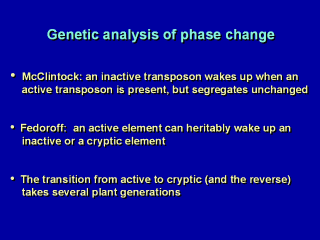| front |1 |2 |3 |4 |5 |6 |7 |8 |9 |10 |11 |12 |13 |14 |15 |16 |17 |18 |19 |20 |21 |22 |23 |24 |25 |26 |27 |28 |29 |30 |31 |32 |33 |review |
 |
McClintock reported in the 1950s that
transposons can undergo reversible, albeit heritable, changes in activity,
behaving as if they’d disappeared, then reappearing. In fact, she believed
that transposons were present in the genome in a silent form, which I later
designated “cryptic,” and she set out to prove it by “evoking” if you will,
a transposon that her friend Marcus Rhoades had identified, but which she’d
never seen in her cultures. And of course she succeeded. She invested a great deal of effort in studying the inactivation and reactivation of the Suppressor-mutator or Spm element. She understood that the Spm transposon could exist in a variety of heritable forms -- epimutants -- that differed in either the frequency, the timing, or the developmental pattern of transposon inactivation and reactivation. In one form, the transposon alternated between active and inactive phases at intervals of a few cell divisions, creating a somatic mosaic for transposon activity. The kernel in the photograph shows the effect of such a transposon on the activity of a gene in the anthocyanin biosynthetic pathway. When the transposon is on, the gene is off and vice versa. She identified other transposon epimutants which were active only in certain tissues or in certain parts of the plant, and still other epimutants that remain largely inactive, returning to an active form very occasionally. Then, in a brilliant series of genetic experiments, she deduced that an active transposon can communicate with an inactive transposon to reactivate it when the two are brought together by a genetic cross. We subsequently showed that the interaction also heritably alters the inactive element. Exposure to an active element promotes the reactivation of an inactive element. But the process takes several plant generations before an inactive element is fully and heritably activated. So McClintock not only discovered transposition, but also provided the first genetic evidence for the existence of an epigenetic modifier. |